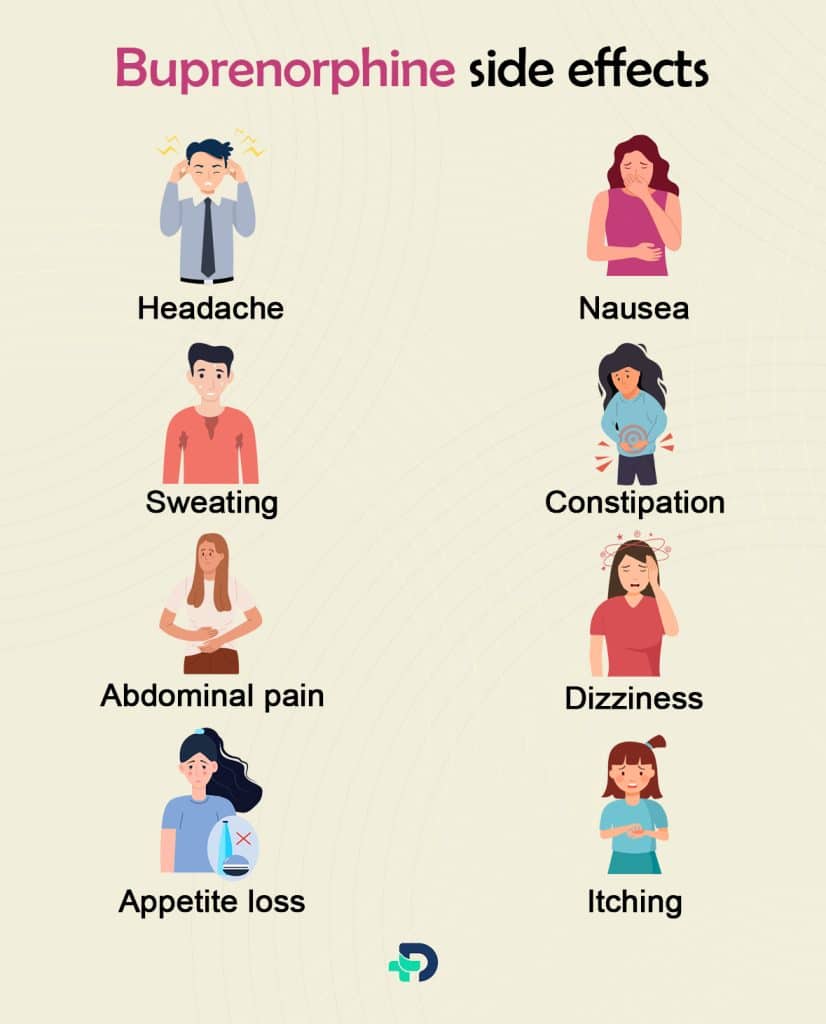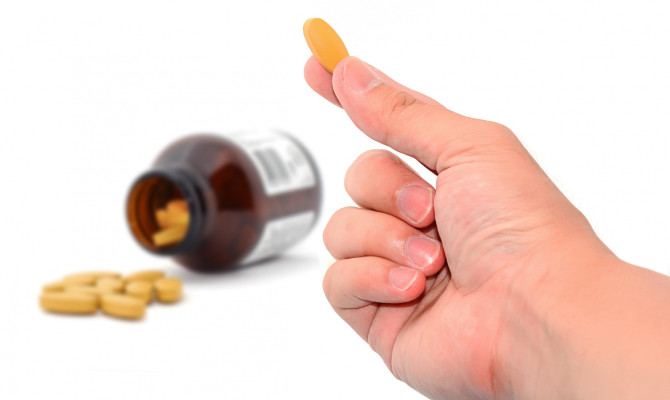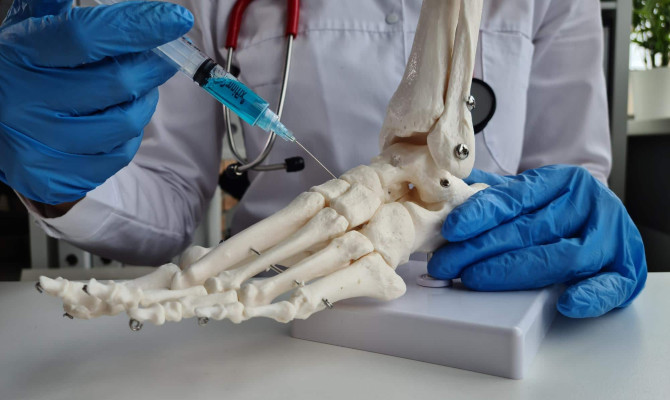Buprenorphine: Uses, Side effects and Precautions

- Buprenorphine
- 17 Aug 2023
Overview
About Buprenorphine
Opioid addiction has developed into a serious public health problem that affects millions of people globally and necessitates innovative treatments that can assist people in overcoming addiction and regaining control over their life.1Theory| Researched based study from Nlm.nih.gov A synthetic opioid medication called Buprenorphine is used to treat both pain and opioid addiction.1Other brand names include Brixadi, Subutex, Buvidal, and Sublocade.
In this article, we will look at the specifics of the medication, its mechanism of action, recommended dosage and administration, side effects, risks, precautions, and drug interactions.

Drug details
- It is a Schedule III narcotic analgesic, which implies it has the potential for low to moderate physical and severe psychological dependence.2Overview| Researched based study from U.s.doj.gov
- It is eliminated in the urine and feces after being broken down by the liver and intestine.1Overview| Researched based study from Nlm.nih.gov
Buprenorphine is available in numerous forms, including
- Sublingual tablets and films are to be administered under the tongue for fast absorption and activity.
- Transdermal patches are to be applied to the skin for continuous, slow medication release.
- Injection – a modified release injection to be delivered under the skin weekly or monthly.3Theory| Researched based study from Healthdirect.gov
Mechanism of action of Buprenorphine
- It works by connecting to the same brain receptors as heroin and prescription medicines.1Overview| Researched based study from Nlm.nih.gov
- This relieves withdrawal symptoms and decreases cravings without creating the intense euphoria or respiratory depression associated with other opioids.
Uses
Uses of Buprenorphine
Buprenorphine is a prescription drug that has the following uses:
- Manages opioid withdrawal symptoms
- Suppresses cravings for opioids
- Mitigates overdose risk
- Enables outpatient treatment
- Manages pain
Reduces withdrawal symptoms
- When people stop using opioids, they experience withdrawal symptoms, and Buprenorphine could help manage them.
- The withdrawal symptoms of Buprenorphine include bodily aches, irritation, anxiety, sweating, and restlessness.4Uses| Researched based study from Nlm.nih.gov
Suppresses cravings
- Buprenorphine lessens the intense cravings felt during withdrawal from opioids and recovery by binding to opioid receptors in the brain.
- This aids people in maintaining their recovery goals.
Mitigates overdose risk
- Due to a unique characteristic of Buprenorphine called the ceiling effect, greater doses do not have the same high-like effects or respiratory depression as other opioids.
- This feature considerably decreases the risk of misuse or overdose.
Enables outpatient treatment
- Buprenorphine, an opioid addiction therapy alternative to methadone, can be provided in an outpatient facility, enabling patients to obtain care without having to go to the clinic every day.
Manages pain
- It is primarily used to treat medium to severe pain that cannot be adequately managed with over-the-counter painkillers, especially after surgery, after a severe injury, or from cancer.5Uses| Researched based study from Nlm.nih.gov
- To treat pain, buprenorphine injections and patches are available. An injection of buprenorphine is approved for adults and kids over the age of 12.
Dosage
Dosage suggestion for Buprenorphine
Buprenorphine dosages will be recommended by the doctor based on the patient’s age, intended use, existing medical conditions, and overall health.
The typical dosages for its usage, however, can be
For opioid dependence/use disorder (OUD)
- To treat opioid dependence, Buprenorphine sublingual tablets are administered in two stages.
- The first phase consists of an induction dose of 2 mg to 8 mg per day, followed by a maintenance phase.
- The recommended dosage of buprenorphine tablets for the maintenance phase of therapy is 4 mg to 24 mg once a day; however, the exact dosage is determined by the patient’s needs and is chosen by the doctor.1Dosage| Researched based study from Nlm.nih.gov
For managing pain
Buprenorphine injections:
- Adults and children aged 12 and up are often given 0.3 mg of buprenorphine injection, followed by a second injection an hour or so later.6Uses| Researched based study from Dailymed.nlm.nih.gov
- If necessary, an injection can be administered every six hours.
- However, based on the severity of the pain, the doctor will choose how frequently to administer injections of Buprenorphine.
Buprenorphine patches:
- The initial dose is determined by whether or not the patient has previously used opioid pain medications.
- Depending on how bad the pain is, the doctor will decide the dosage and frequency of its use.
- It is only recommended for adults.
How to take Buprenorphine?
Buprenorphine administration is possible via many means.
Transdermal patch
- Wash and dry the area where you plan to apply the patch.
- Take the protective lining off the transdermal patch immediately press the adhesive side onto the desired region of the skin using your palm.
- Using your palm, immediately press the patch’s sticky side on the skin’s surface.
- Firmly press the patch for at least 15 seconds and ensure that the patch adheres effectively to your skin, especially the edges.
- Be sure to follow all advice carefully.7Dosage| Researched based study from Medlineplus.gov
Sublingual tablets
- Take this medication by mouth around the same time every day.
- The drug is dissolved by placing it under the tongue.
- Avoid chewing, cutting, or swallowing the tablets.8Dosage| Researched based study from Clevelandclinic.org
Parenteral routes (through injections or implants)
- Subcutaneous implant
- Subdermal implant
- Intravenous (IV) injections
- Intra muscular injections (IM)
Side effects

Buprenorphine side effects
The most common side effects of Buprenorphine are:
- Headache
- Nausea
- Increased sweating9Side effects| Researched based study from Adf.org.au
- Constipation
- Abdominal pain
- Dizziness
- Drowsiness after a dose
- Appetite loss
- Memory loss
- Dry mouth1Side effects| Researched based study from Nlm.nih.gov
- Vomiting
- Weight gain in females
- Irregular menstruation
- Decreased sex drive – in men and women
- Itching, Skin rashes, or hives.
Precautions
What precautions needs to be taken when using Buprenorphine?
- Buprenorphine should not be used in people with hypersensitivity to this medicine.
- Buprenorphine use during pregnancy has been linked to a syndrome of opioid withdrawal in infants10Precautions| Researched based study from Fda.gov
- Buprenorphine can enter breast milk and provide a risk to nursed children, so breastfeeding mothers should discuss this with their doctors.
- Like other opioids, buprenorphine could be addictive and can be abused. Thus, patients should be watched for signs of addiction and the advancement of opioid dependency.
- Opioid withdrawal is a possibility if medication is briefly stopped. Thus, patients should be watched for it and given the proper care.
- While using buprenorphine, the risk of fatal respiratory depression and death increases if benzodiazepines or other CNS depressants are self-administered10Precautions| Researched based study from Fda.gov
- Buprenorphine can cause severe, potentially deadly respiratory depression in children. Therefore, it should be stored away from children’s sight and reach.
- Buprenorphine increases the risk of liver damage, and the patient’s liver function should be evaluated before starting and during the treatment.
- It is not advised to take buprenorphine as a pain reliever without a prescription.
- Those who have been given an adrenal insufficiency diagnosis should avoid using this medication because Buprenorphine may worsen this condition, which is risky.
Contraindications
Who should avoid taking Buprenorphine?
Buprenorphine can make the conditions of the following people worse. They should thus discuss it with their doctor:
- Those who experience respiratory issues like asthma or wheeze.
- People who are inherently weak or over the age of 65.
- Individuals who experience intestinal issues.
- People who have enlarged prostates or have a hard time urinating.
- Those who have liver issues.
- Those who have gallbladder or pancreas issues.
- People who already have heart issues because they are more likely to experience heart failure or a slow, irregular heartbeat.
- Sufferers of seizure disorders, such as epilepsy.
Other considerations when using Buprenorphine include the following:
- People taking this medication should avoid driving and operating machinery since it can impair a person’s physical and mental capabilities.
- Exposing buprenorphine patches to heat, such as in saunas, electric blankets, heating pads, or excessive sunlight, can speed up the drug’s absorption into the body and increase the risk of an overdose or, rarely, death.7Contraindications| Researched based study from Medlineplus.gov
- If the person starts breathing slowly or shallowly or begins to feel extremely tired or disoriented, call the doctor right once. These signs of a buprenorphine overdose are possible.
Interactions
Interactions of Buprenorphine
The following may include a few of the drugs that are known to interact with Buprenorphine:
- Benzodiazepines or other CNS suppressants, including alcohol – have the possibility of respiratory depression, extreme sedation, coma, and death when used with Buprenorphine.11Interactions| Researched based study from Nlm.nih.gov
- CYP3A4 inhibitors – can intensify and extend the opioid effects when used with Buprenorphine.11Interactions| Researched based study from Nlm.nih.gov
- CYP3A4 inducers – potentially lessen the effectiveness of Buprenorphine or the start of a withdrawal episode in patients who have grown physically dependent on it.10Interactions| Researched based study from Fda.gov
- Antiretrovirals – like atazanavir and ritonavir, when taken with Buprenorphine, the doctors may need to lower the dosage of Buprenorphine.10Interactions| Researched based study from Fda.gov
- Muscle relaxants – Buprenorphine may improve the neuromuscular blocking action of muscle relaxants, resulting in more significant respiratory depression.10Interactions| Researched based study from Fda.gov
- Diuretics – Opioids can cause the release of the hormone antidiuretic hormone, which can decrease the effectiveness of diuretics.10Interactions| Researched based study from Fda.gov
- Anticholinergic medications – when taken along with Buprenorphine- may raise the risk of urine retention and extreme constipation, which may result in paralytic ileus.10Interactions| Researched based study from Fda.gov
People need to discuss all the medications they take with their doctors, including prescription and over-the-counter medicines, as this list may not have included all of the drugs that potentially interact with Buprenorphine. Any use of illegal substances, alcohol use, or smoking should be disclosed to your doctors as there could be a conflict between the drug and specific products.
Any feedback on this article?
 This Articles content was accurate
This Articles content was accurate Very Informative Article
Very Informative Article I have a question or a comment
I have a question or a comment
 This article contains inaccurate content
This article contains inaccurate content This article was not helpful
This article was not helpful I have a question or a comment
I have a question or a comment
We appreciate your helpful feedback!
Checkout our social pages
References
-
National Library of Medicine
Buprenorphine | Overview
-
DRUG ENFORCEMENT ADMINISTRATION
BUPRENORPHINE | Overview
-
Health Direct
Buprenorphine | Overview
-
National Library of Medicine
Buprenorphine for managing opioid withdrawal | Uses
-
National Library of Medicine
Buprenorphine for Chronic Pain: A Safer Alternative to Traditional Opioids | Uses
-
DailyMed
BUPRENORPHINE HYDROCHLORIDE- buprenorphine hydrochloride injection, solution Hospira, Inc. | Dosage
-
Medline Plus
Buprenorphine Transdermal Patch | Dosage
-
Cleveland Clinic
Buprenorphine Sublingual Tablets | Dosage
-
Alcohol and Drug Foundation’s services
Buprenorphine | Side effects
-
U.S.FOOD AND DRUG ADMINISTRATION
Buprenorphine | Contraindications
-
National Library of Medicine
Associations between prescribed benzodiazepines, overdose death, and buprenorphine discontinuation among people receiving buprenorphine | Interactions




































